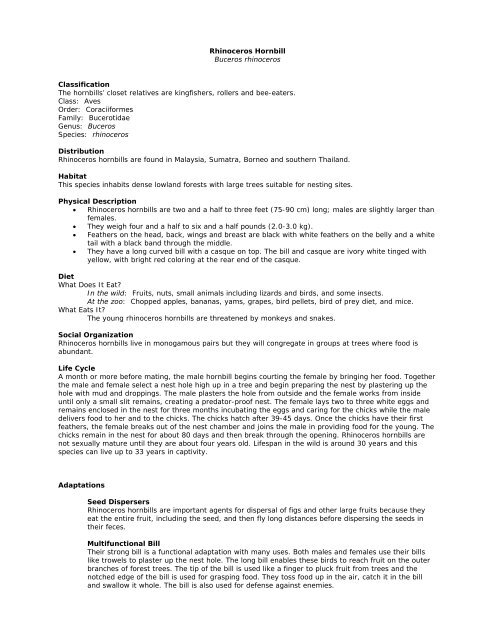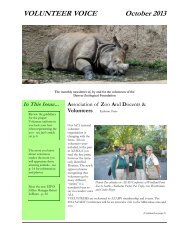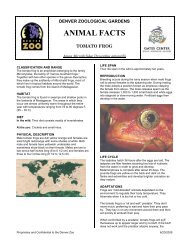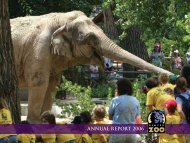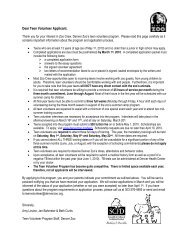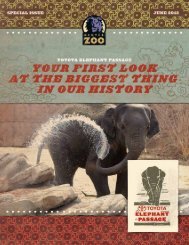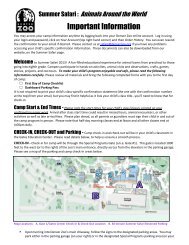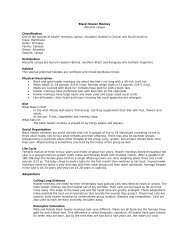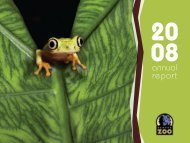Rhinoceros Hornbill Buceros rhinoceros Classification ... - Denver Zoo
Rhinoceros Hornbill Buceros rhinoceros Classification ... - Denver Zoo
Rhinoceros Hornbill Buceros rhinoceros Classification ... - Denver Zoo
You also want an ePaper? Increase the reach of your titles
YUMPU automatically turns print PDFs into web optimized ePapers that Google loves.
<strong>Rhinoceros</strong> <strong>Hornbill</strong><br />
<strong>Buceros</strong> <strong>rhinoceros</strong><br />
<strong>Classification</strong><br />
The hornbills’ closet relatives are kingfishers, rollers and bee-eaters.<br />
Class: Aves<br />
Order: Coraciiformes<br />
Family: Bucerotidae<br />
Genus: <strong>Buceros</strong><br />
Species: <strong>rhinoceros</strong><br />
Distribution<br />
<strong>Rhinoceros</strong> hornbills are found in Malaysia, Sumatra, Borneo and southern Thailand.<br />
Habitat<br />
This species inhabits dense lowland forests with large trees suitable for nesting sites.<br />
Physical Description<br />
• <strong>Rhinoceros</strong> hornbills are two and a half to three feet (75-90 cm) long; males are slightly larger than<br />
females.<br />
• They weigh four and a half to six and a half pounds (2.0-3.0 kg).<br />
• Feathers on the head, back, wings and breast are black with white feathers on the belly and a white<br />
tail with a black band through the middle.<br />
• They have a long curved bill with a casque on top. The bill and casque are ivory white tinged with<br />
yellow, with bright red coloring at the rear end of the casque.<br />
Diet<br />
What Does It Eat?<br />
In the wild: Fruits, nuts, small animals including lizards and birds, and some insects.<br />
At the zoo: Chopped apples, bananas, yams, grapes, bird pellets, bird of prey diet, and mice.<br />
What Eats It?<br />
The young <strong>rhinoceros</strong> hornbills are threatened by monkeys and snakes.<br />
Social Organization<br />
<strong>Rhinoceros</strong> hornbills live in monogamous pairs but they will congregate in groups at trees where food is<br />
abundant.<br />
Life Cycle<br />
A month or more before mating, the male hornbill begins courting the female by bringing her food. Together<br />
the male and female select a nest hole high up in a tree and begin preparing the nest by plastering up the<br />
hole with mud and droppings. The male plasters the hole from outside and the female works from inside<br />
until only a small slit remains, creating a predator-proof nest. The female lays two to three white eggs and<br />
remains enclosed in the nest for three months incubating the eggs and caring for the chicks while the male<br />
delivers food to her and to the chicks. The chicks hatch after 39-45 days. Once the chicks have their first<br />
feathers, the female breaks out of the nest chamber and joins the male in providing food for the young. The<br />
chicks remain in the nest for about 80 days and then break through the opening. <strong>Rhinoceros</strong> hornbills are<br />
not sexually mature until they are about four years old. Lifespan in the wild is around 30 years and this<br />
species can live up to 33 years in captivity.<br />
Adaptations<br />
Seed Dispersers<br />
<strong>Rhinoceros</strong> hornbills are important agents for dispersal of figs and other large fruits because they<br />
eat the entire fruit, including the seed, and then fly long distances before dispersing the seeds in<br />
their feces.<br />
Multifunctional Bill<br />
Their strong bill is a functional adaptation with many uses. Both males and females use their bills<br />
like trowels to plaster up the nest hole. The long bill enables these birds to reach fruit on the outer<br />
branches of forest trees. The tip of the bill is used like a finger to pluck fruit from trees and the<br />
notched edge of the bill is used for grasping food. They toss food up in the air, catch it in the bill<br />
and swallow it whole. The bill is also used for defense against enemies.
Distinctive Casque<br />
The distinctive casque on top of their bill looks heavy and cumbersome. Composed of keratin<br />
overlying bony support, the casque is very strong and relatively lightweight. The casque is used in<br />
recognizing the age, sex and species of the hornbill. It also acts like a resonating chamber that<br />
amplifies their loud squawks.<br />
Conservation Connection<br />
IUCN Status: Near Threatened.<br />
<strong>Rhinoceros</strong> hornbills are listed as near threatened due to loss of habitat, poaching for their feathers and<br />
hunting for food.<br />
Fun Facts<br />
• When flying, the wings of the hornbill make a loud humming sound that can be heard up to 65 feet<br />
away.<br />
• Males have red eyes and females have white eyes.<br />
• <strong>Hornbill</strong>s have very long eyelashes that protect their eyes from injury. The eyelashes are actually<br />
modified feathers.<br />
• <strong>Hornbill</strong>s are the only birds that have the first two neck vertebrae fused together. Along with strong<br />
neck muscles, the fusion of the vertebrae helps support the weight of their large bill and casque.<br />
• While enclosed in the nest chamber, the female undergoes a simultaneous molt of all flight and tail<br />
feathers. She grows new feathers by the time she emerges from the nest.


